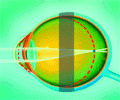Researchers from Sandia National Laboratories, led by principal investigator Susan Rempe, are part of a multi-institutional, multidisciplinary team developing a nano-size battery that one day could be implanted in the eye to power an artificial retina.
They are among the recipients of a five-year, $6.5 million grant recently awarded by the National Eye Institute of the US National Institutes of Health (NIH) to establish a new centre, the
The centre will design, model, synthesise, and fabricate nanomedical devices based on natural and synthetic ion transporters, proteins that control ion motion across the membranes of every living cell.
The first task for the centre will be to design a class of devices for generating electric power - bio-batteries - for a wide array of implantable devices, starting with an artificial retina that has already been developed at the Doheny Eye Institute at the
Sandia’s role is on the theoretical and computational side of the project, Rempe says.
“We will use our expertise in multi-scale modelling to understand and predict how transporter structure leads to function, with an initial focus on specialised transporters found in the electric eel,” Rempe says. “This information will give us a better understanding of how power is naturally created in biological organisms, information to be used for designing and building the nanobattery.”
Ultimately the algorithms, software, design expertise, and scientific knowledge gained through the modelling efforts, in which Rempe is joined by Kevin Leung and Steve Plimpton, will be shared with the external community through workshops, seminars, conferences, and collaborations.
Working on another aspect of the project is Jeff Brinker, who is affiliated with both Sandia and the
The team plans to translate several categories of biological function into new devices that would treat disease and lead to implantable devices. Properties of interest that appear in the biological ion transporters include electrical signalling, osmotic pumping, and molecular detection.

Schematic of nanobattery that would be implanted in or near the eye










Comment: The UK is closer to deindustrialisation than reindustrialisation
"..have been years in the making" and are embedded in the actors - thus making it difficult for UK industry to move on and develop and apply...